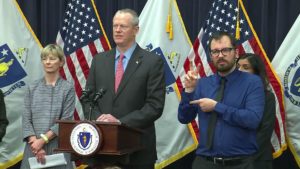As of the time of writing (23 March 2020), 777 people in Massachusetts have been confirmed infected with the SARS-COV-2 virus, better known as the novel coronavirus that causes the flu like disease, COVID-19. 9 people in the state have already died and numbers of infections are continuing to increase day by day with little sign yet of any flattening of the infection curve.
Massachusetts is not the worst hit place in the country. That’s probably New York City right now. But the situation was already grave enough for the state’s Governor, Charlie Baker, to declare a state of emergency earlier this month. It is significant that the infection tally at that point had only reached 92, so it has climbed by 685 in the last 13 days. Such is the power of exponential community transmission. The Governor’s declaration was in addition to the federal proclamation of a national emergency which the Trump administration signed into effect on March 13th, following the World Health Organization’s declaration of a world pandemic.
States of emergency, at least in Massachusetts, are relatively rare events. In the more distant past they were used during the Civil War. More recently, they have been announced when there has been some sort of natural or man-made disaster, like the aftermath of Hurricane Sandy, and more recently in September 2018 after the Merrimack valley gas explosions.
The present state of emergency has been passed using legislation made back in 1950. It’s not the only measure that the state government could have used, as there is also a public health emergency provision as well as federal orders like the current federal national emergency, but it’s the 1950 legislation that dictates what the state’s Governor can and cannot do in the current crisis.
The powers enabled by the state of emergency
By signing the state of emergency, the state government is given extraordinary powers to exert control over the lives of Massachusetts’ citizens. The legislation states that “the Governor, in addition to any other authority vested in him by law, shall have and may exercise any and all authority over persons and property necessary or expedient for meeting said state of emergency, which the general court in the exercise of its constitutional authority may confer upon him.”
Most importantly, the Governor can take control over any or all state resources, including state employees and any federal resources provided by the federal government. The state of emergency also allows the Governor to impose other more temporary laws as he sees fit that enable the state government to best grapple with the effects of COVID-19.
Some of the things that the Governor can do include limiting the number of people who can assemble at any point in time, the opening or closure of businesses and non-essential services, regulate purchases made by the state, implement curfews, regulate the sale of food and other commodities, order evacuations, and any other regulation that aims to protect the health and lives of the state’s residents.
What has the state of emergency led to so far?
Massachusetts has not yet gone down the road of some other states where the infection rate has risen more sharply. A third of Americans are now in virtual lockdown, urged to stay at home to prevent the transmission of the virus. Massachusetts has yet to follow the same path as states like California, New York, New Jersey and Illinois, but could do so in the near future. Here are some of the measures that have followed the state of emergency so far:
- restaurants and bars are limited to take-out and delivery only;
- currently schools are suspended for several weeks;
- no public gatherings allowed over 25 people;
- nursing homes and assisted living facilities are required to restrict visitors;
- hospitals are required to restrict visitors and cancel non-essential elective procedures;
- the RMV is extending renewal timelines for some credentials.
In addition, bills have been introduced to help workers made unemployed by businesses that have had to close by bringing forward mandatory unemployment benefits.
How are the Federal Government’s National Emergency Powers Different?
While the state government has ultimate control over what it does in relation to tackling the COVID-19 crisis, the National Emergency proclamation can make a significant contribution, especially by releasing enormous reserve funds made available by the federal government. By declaring a National Emergency, federal agencies like the Federal Emergency Management Authority (FEMA), the Health and Human Services Department (HHS) and the Center for Disease Control and Prevention (CDC) take a leading role in combating the effects of the virus.
Each of these agencies has a distinct role to play but will be coordinating their efforts with each other as well as with the various state governments. For example, FEMA can use its formidable reserves of stockpiled commodities. The lead agency will be the HHS, which has been given broad, new powers which enable it to alter or cancel existing health legislation and regulations permitting the maximum flexibility for hospitals and health professionals in their response to the virus.
Americans are currently facing the most serious economic and social crisis since the Great Depression, but the spread of COVID-19 is not uniform across the U.S. State emergency powers allow each state to maximize their government’s individual response to the virus, while federal emergency powers allow funding and resources to be channeled wherever in the country they are most needed.


